|
A
Little Fantail Steam Launch
by Weston Farmer |
|
No Rationing Problem on Fuel. Run her
on Driftwood and You'll Get There and Get Back on Tine if You
Know When to Turn Around
(Published in December, 1943)
This little kewpie was done for the drool cup, flute and cuspidor.
I think she'll water the mouths of all oldtimers who love tuggish
lines, for she is a fantail. Her power plant, too, will be a
hark-back to all who have known and who love the gentle reliability
of steam.
As she is shown in the drawings
she is buildable and runable. The boat is all engineered out,
and anyone capable of building the engine can draw the parts up
from dimensions, making his own assembly drawing, then detailing
the parts.
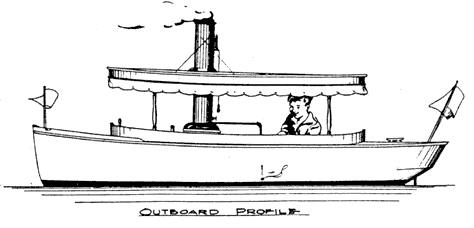
I did the model of her about ten
years ago. No editor then would listen to publication, possibly
because I had no drawings at the time. Following Pearl Harbor,
with M-day freeze-ups on advertised engines, fireside dreaming
became the main unrationable dish on most editors' pages. Hence,
when I popped into the RUDDER office after a two year absence
afield on Navy designing. Editor Boris had the spot and the time
was ripe to publish the drawings of Feeble.
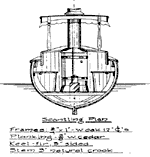 But
there is more to her background: when I was a tot my family owned
a little steamer up on Lake Superior at Isle Royale. Atalanta
she was named. Thirty feet long, canopy, and all that sort of
thing. I remember picnics at Rock Harbor Lodge when after breakfast
some life-of-the-party, dressed in peg top pants, bulldog shoes,
high celluloid collar and carpetbag cap, would propose an all
day picnic. All day, because Atalanta would take half a day to
steam up, run six miles down Rock Harbor and come back with her
fulsome tow of twenty rowboats loaded with cackling big bustled
schoolmarms. It may be the nostalgia of the odor of hot 600W oil
emitting from the Atalanta's blowoff cocks that had a hand in
shaping my desire to someday own a tabloid version of the little
steamer. But
there is more to her background: when I was a tot my family owned
a little steamer up on Lake Superior at Isle Royale. Atalanta
she was named. Thirty feet long, canopy, and all that sort of
thing. I remember picnics at Rock Harbor Lodge when after breakfast
some life-of-the-party, dressed in peg top pants, bulldog shoes,
high celluloid collar and carpetbag cap, would propose an all
day picnic. All day, because Atalanta would take half a day to
steam up, run six miles down Rock Harbor and come back with her
fulsome tow of twenty rowboats loaded with cackling big bustled
schoolmarms. It may be the nostalgia of the odor of hot 600W oil
emitting from the Atalanta's blowoff cocks that had a hand in
shaping my desire to someday own a tabloid version of the little
steamer.
So when I grew up—beg pardon,
when I was twenty-one, I had a good half-hitch on a form of personal
religion which has since become a fetish: I put away the thought
of foolish things and went all out for this kind of monkey business,
holding a firm belief in the serious importance of doing Rover
Boy stuff just for the hell of it. I ordered an engine designed
for the boat from the eminent English model engineer Henry Greenly.
The only specification I stipulated was one-half horsepower, double
acting and reversible. The design finally arrived from across
the Atlantic. The entire sheaf of drawings cost fifteen dollars,
lock, stock and barrel. Henry must have been eating sparingly.
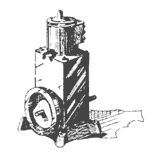 Next
I had the engine built in my experiment station. Then from a firm
in Chicago I bought a boiler. The real goods—21 fire tubes,
gauge glass, safety valve and all. I remember uncrating this wonderful
piece of the boilermaker's art one winter day in a Minneapolis
alley. The whole forty dollars' worth was soon hooked up to the
steam box in my shop and together we cooked the planks for Scram,
a little runabout then a-building. Just like the man who started
to build his house around a doorknob! Next
I had the engine built in my experiment station. Then from a firm
in Chicago I bought a boiler. The real goods—21 fire tubes,
gauge glass, safety valve and all. I remember uncrating this wonderful
piece of the boilermaker's art one winter day in a Minneapolis
alley. The whole forty dollars' worth was soon hooked up to the
steam box in my shop and together we cooked the planks for Scram,
a little runabout then a-building. Just like the man who started
to build his house around a doorknob!
The hull for our Feeble here was
in my mind's eye then. She was complete and integrated and, coming
to life on paper now, she certainly has that essential period
of mulling back of her. That gestating period is behind every
thorough piece of art.
So much for flavor. Here's the technical dope: length overall
12 feet 3 inches, beam molded 48 inches, draft 16-1/2 inches—you
gotta get these big boats down, brother. . . the draft, as my
friend Ole Bergkvam would 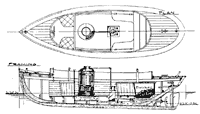 say,
"will wary". She'll wary, within limits, to about 18
inches. The displacement, as I reckon it, will come to about 1,005
pounds, so she is no cream puff. Nor will she act like one. lt'll
take her some time to decide to get away from the dock once you
shoot the steam to her, but when she's made up her mind there'll
be no stopping her. Not even with a quarter-inch cotton clothes
rope—that is, unless you reverse in time. For this primidisical
function of every steam engine, Henry Greenly pulled a new one
in his engine design. At least it was new to me, used to seeing
Stephenson links or modified Walschaert valve linkage. Henry simply
made a slip eccentric with a peg on it that catches a collar fixed
to the crankshaft web. When she's properly timed for running forward
she's properly timed for running forward. When you want back-up,
you shut off the steam, flip the flywheel half a turn in reverse,
and she is properly timed for running backwards. So you open up
the steam valve and go that way. say,
"will wary". She'll wary, within limits, to about 18
inches. The displacement, as I reckon it, will come to about 1,005
pounds, so she is no cream puff. Nor will she act like one. lt'll
take her some time to decide to get away from the dock once you
shoot the steam to her, but when she's made up her mind there'll
be no stopping her. Not even with a quarter-inch cotton clothes
rope—that is, unless you reverse in time. For this primidisical
function of every steam engine, Henry Greenly pulled a new one
in his engine design. At least it was new to me, used to seeing
Stephenson links or modified Walschaert valve linkage. Henry simply
made a slip eccentric with a peg on it that catches a collar fixed
to the crankshaft web. When she's properly timed for running forward
she's properly timed for running forward. When you want back-up,
you shut off the steam, flip the flywheel half a turn in reverse,
and she is properly timed for running backwards. So you open up
the steam valve and go that way.
The engine is simplicity itself
in every other phase. Bored 1-3/4 inches, with a stroke of 2-1/2
inches, I have no fear but what she'll swing a 9 by 9 inch two
bucket wheel about 600-800 revolutions. It all depends on the
grade of fuel used and the pep in your firing arm. The cylinder
is of iron, as is the base, piston, cross head slide, D valve
chamber and flywheel. The piston rod is 1/4 inch drill rod. I
used two piston rings from a Johnson outboard.
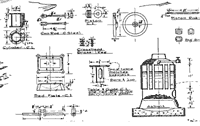 The
cross head is of red brass. So are the crank Journal and main
crank bearings, also the D valve itself. The pillars are of half-inch
cold rolled bar stock turned and threaded on the foot and head
ends. The con rod spec called for cast steel, and so cast steel
she was. The crankshaft was made by cutting the webs out, boring
them to fit over c.r. steel rod, welding the thing up, cutting
out the through piece, and turning off a hair to give us trueness. The
cross head is of red brass. So are the crank Journal and main
crank bearings, also the D valve itself. The pillars are of half-inch
cold rolled bar stock turned and threaded on the foot and head
ends. The con rod spec called for cast steel, and so cast steel
she was. The crankshaft was made by cutting the webs out, boring
them to fit over c.r. steel rod, welding the thing up, cutting
out the through piece, and turning off a hair to give us trueness.
The piping to and from the boiler
will all be Crane brass, with Crane brass fittings. Yeah—yeah,
I know priorities. Only when I got the stuff together there were
no priorities. Besides, dream your own pipe, brother—I can't
help on that one. But I don't see why ordinary stuff couldn't
be used. The boiler is set to blow at forty pounds or rnaybe sixty,
so what will hold water pressure will hold that much steam. A
simple Lunkenheimer Roscoe-type lubricator will take care of lubrification.
You know—the thing is just a water trap in series with the
steam line right near the steam chest; water condenses in the
trap and floats the oil out into the workings.
The boiler itself is cradled on
some husky chunks of birch, pine or other stuff—not oak,
which will rot—and the whole thing will have to be liberally
bolstered with concrete under the ash pit, albeit away from the
hull so you won't cook your boat. Lunkenheimer still makes a whistle
that sounds about like a soused bo'sun piping down all hands.
I think I'll rig one up just to scare the ducks out of the wilderness.
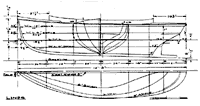 As
to fuel, anthracite will be ideal. But if you want a real, smoky,
stinky steamboat, burn a mixture of pea coal (for B.T.U.'s) and
cannel coal (for smudge). That will give you what is known in
artistic circles as verisimilitude. As
to fuel, anthracite will be ideal. But if you want a real, smoky,
stinky steamboat, burn a mixture of pea coal (for B.T.U.'s) and
cannel coal (for smudge). That will give you what is known in
artistic circles as verisimilitude.
For my gang of boys, should Feeble
come to life this summer as she now bids fair to, I'll supply
the outdoors and they can supply the driftwood on the beaches
of Isle Royale. If they are still hauling pulpwood booms down
out of the Nipigon across Point Porphyry way into the upper peninsula
of Michigan, we'll have all the fuel necessary to make a China
crossing.
Other details are self evident
if you are sufficiently interested to build. Nearly everything
important seems to have been covered, space is running out, so
I'll close shortly with just a word of explanation as to her name.
It's easy.
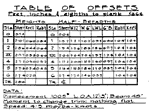 When
I finished up the little thumbnail perspective off to the starboard
end of my drawing board, I glanced over to port and looked at
the work there. It was a plan for the engine room of the Vosper
PT boats, showing machinery installation stuff on which I had
been working during the day. Alongside that maze of guts a Mergenthaler
linotype looks like a hunk of old lead pipe. I glanced back at
the peaceful little sketch of the steamer . . . she seemed ghosting
like a dainty shallop in tranquil waters. I wondered what to name
her. And with the thoughtful search for a name, I couldn't help
musing on what price progress—to port on my drawing board,
100 octane gas, a forest of cylinders, temperature, pressure gauges
by the galaxy; to starboard . . . well, if you could light a match
and there was water in the lake, you'd go. I didn't then reflect
that if you light a match around 100 octane, you'd go too. I just
caught the spirit of the times she represents, the thought behind
her, and with a fond sigh, lettered on her bow the name Feeble. When
I finished up the little thumbnail perspective off to the starboard
end of my drawing board, I glanced over to port and looked at
the work there. It was a plan for the engine room of the Vosper
PT boats, showing machinery installation stuff on which I had
been working during the day. Alongside that maze of guts a Mergenthaler
linotype looks like a hunk of old lead pipe. I glanced back at
the peaceful little sketch of the steamer . . . she seemed ghosting
like a dainty shallop in tranquil waters. I wondered what to name
her. And with the thoughtful search for a name, I couldn't help
musing on what price progress—to port on my drawing board,
100 octane gas, a forest of cylinders, temperature, pressure gauges
by the galaxy; to starboard . . . well, if you could light a match
and there was water in the lake, you'd go. I didn't then reflect
that if you light a match around 100 octane, you'd go too. I just
caught the spirit of the times she represents, the thought behind
her, and with a fond sigh, lettered on her bow the name Feeble.
|

